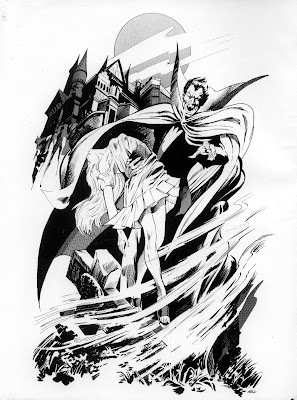DC Showcase Presents: Batman, Volume One (DC Comics, 2007)
Writers: Ed Herron, Gardner Fox, John Broome, and Bill Finger
Artists: Carmine Infantino, Bob Kane, Murphy Anderson, and Various
Rating: Five of Ten Stars
Batman and the characters of the Fantastic Four are my favorite superheroes. But the FF left me behind some time in the early 1990s--the issue with the image of the Wizard snatching Franklin from a sleeping Ben Grimm is the last FF story I acknowledge--and Batman moved beyond me around the time "Batman Year Two" saw print.
With the FF, I LOVE everything from the first issue (where they were Kirby's recasting of DC's Challengers of the Unknown with superpowers) through the above-mentioned issue, which was #302 or something like that. I like the FF as porrtrayed in the "Spider-Girl" M2 universe, but mainline Marvel is dead to me. (Okay... I could do wihtout most of the Inhumans, but Crystal and her romance with Johnny I liked.)
With Batman, I LOVE just about everything from the late 1970s through the early 1990s... "Detective Comics", "Batman", "Batman Family", "The Brave & the Bold", "Worlds Finest's Comics"... I love 'em all. The Doug Moench scripted, Don Newton/Gene Colan/Alfredo Alcala illustrated tales in "Detective" and "Batman" are the high points of my Batman experience, along with the Bob Haney-written, Jim Aparo illustrated tales from "The Brave and the Bold".
So, I figured I'd enjoy "Showcase Presents: Batman"--a massive, 500+ page book reprinting stories from "Detective Comics" #327-342 and "Batman" #164-174--because I love the FF from the same period, and I greatly enjoy the 1960s Batman TV show.
I was, however, wrong. While I detest the psychotic, grim-and-gritty Batman that came into fashion in the 1990s, I found myself equally turned off by the frivolous stories in this volume. They were virtually all forgettable, too cutesy and self-consciously camp, and downright embarrassing whenever they attempted to get "hip." Even the great artwork of Carmine Infantino can't dress up these turkeys... and the always mediocre Bob Kane only manages to drag down a few of the better tales. (Yes, he created Batman... and yes, I enjoy the early tales he produced. But there were far more talented creators working at the same time he was.)

There were a few memorable highlights--such as when the killed off Alfred to the point where his dead body is even shown on panel--and a handful of borderline film-noir crime tales and a couple of stories featuring Patricia Powell, a clever police woman and potential romantic interest for both Bruce Wayne and Batman. (The only two things I'm curious about in this book is how Alfred came back to life, and whatever happened to Powell. Maybe I'll have to pick up Volume 2 and find out.)
It's interesting to me that Batman is such a huge character, given that comics from the same period featuring Hawkman, Elongated Man, and the Flash were so vastly superior. The power of marketing and branding at work, I suppose. I can, however, easily see why Marvel Comics caught on the way they did. The quality of those early Marvel tales are heads and shoulders above those featuring the DC headliners of Superman and Batman.















